Archive for December, 2017
-
MAN ON A MISSION
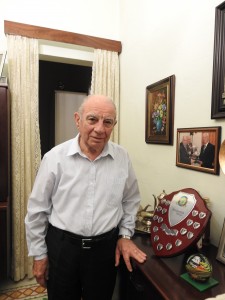 “Ageing should not be a barrier in life but a further opportunity to excel,” insists 80-year-old Angelo Zahra who has recently been selected to receive the main prize in the award ‘Premju Anzjanità Attiva’ (Award for the Active Ageing) for his voluntary management of three homes for the disabled.
“Ageing should not be a barrier in life but a further opportunity to excel,” insists 80-year-old Angelo Zahra who has recently been selected to receive the main prize in the award ‘Premju Anzjanità Attiva’ (Award for the Active Ageing) for his voluntary management of three homes for the disabled.Zahra studied mechanical engineering at the Dockyard Technical College and for several years, he served in managerial roles. Before his retirement, at age 63, he was the Director of the Manufacturing and Services Department with the Government of Malta.
“I have known Fr Angelo Seychell since his priesthood and I have always admired his work. When he founded the Nazareth Foundation in 1995 and opened his house to provide a home for people with special needs, I supported his venture by collecting donations from my colleagues twice a year. However, I was not directly involved with Dar Nazareth.”
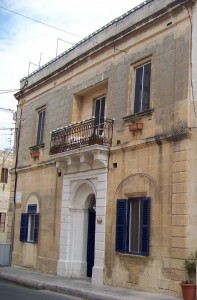 Yet Fr Seychell had for long earmarked Zahra to help him develop his mission to create a warm family environment in which people with disabilities could lead a good and respectful life which gave them the possibility to be happy and to achieve their full potential.
Yet Fr Seychell had for long earmarked Zahra to help him develop his mission to create a warm family environment in which people with disabilities could lead a good and respectful life which gave them the possibility to be happy and to achieve their full potential.“As soon as I retired, Fr Seychell approached me and asked me to consider serving as the administrator of Dar Nazareth. I accepted on condition to start three months later since I had promised my wife that I would finally take a much-awaited break from work. In the meantime, my wife and I booked a tour to Lourdes and to our great surprise we found out that the group which we were going to travel with were none other than Fr Seychell, his volunteers and the residents at Dar Nazareth. This was a golden opportunity to get to know everyone better and soon, I was deeply involved with the Nazareth Foundation.”
 “In September 2000, when I joined in, there were only five residents at Dar Nazareth. However, in a short time, the house was elaborated to receive a further five residents where it reached its full capacity. A year later, the Foundation rented a workshop wherein our residents could attend daily to entertain themselves and to make crafts which could be sold to the public.”
“In September 2000, when I joined in, there were only five residents at Dar Nazareth. However, in a short time, the house was elaborated to receive a further five residents where it reached its full capacity. A year later, the Foundation rented a workshop wherein our residents could attend daily to entertain themselves and to make crafts which could be sold to the public.”Dar Nazareth addressed a demand which had been stalled for several years. Soon, its success lead to the establishment of two other houses.
“In 2004, the Foundation opened the second house, Dar l-Arċipriet Degabriele, which welcomed a further nine residents. Five years later, the third house, Dar Jean Vanier, opened its doors to another nine residents.”
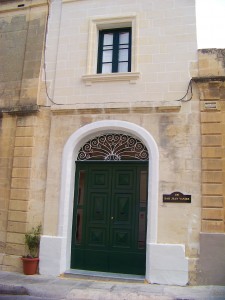 While in the beginning Dar Nazareth was operated by volunteers, the increase in residents and houses required the engagement of full-time workers.
While in the beginning Dar Nazareth was operated by volunteers, the increase in residents and houses required the engagement of full-time workers.“The funding of such projects is always one of the major stumbling blocks. The Foundation had succeeded to purchase two properties and develop them into residential homes. It also managed to acquire enough money to fund the salary of 30 full-time workers. Nevertheless, the sourcing of further income to sustain all the expenses required to keep these three homes functioning are a constant responsibility. Thankfully, in 2016, the Government signed an agreement with Nazareth Foundation through which it was given 1.4 million euro over a period of three years. This serves as a safety net for the Foundation’s administration to provide the best service possible to its residents.”
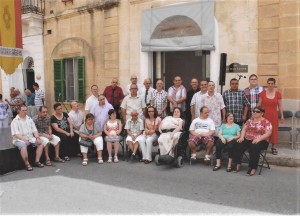 For the past 17 years, Zahra has voluntarily taken in hand the management of these three homes and presently he also acts as President of the Nazareth Foundation Board.
For the past 17 years, Zahra has voluntarily taken in hand the management of these three homes and presently he also acts as President of the Nazareth Foundation Board.“This work has become my mission to do something worthwhile with my available time. It gives me utter satisfaction to see our residents living in a friendly and family environment where they can feel safe, at ease, and loved. Their appreciation and happiness in return give me a sense of fulfilment and help me to feel much younger.”
(This feature was published in SENIOR TIMES – DECEMBER 2017 issued with The Times of Malta)
-
IBGĦATHIELI BIL-POSTA
 “Il-Milied ta’ dari kien inqas kummerċjali minn dak ta’ llum u dan huwa saħansitra evidenti minn dak li tirċievi fil-posta,” għarrafni missieri Saviour Busuttil li qatta’ 37 sena jaħdem bħala pustier.
“Il-Milied ta’ dari kien inqas kummerċjali minn dak ta’ llum u dan huwa saħansitra evidenti minn dak li tirċievi fil-posta,” għarrafni missieri Saviour Busuttil li qatta’ 37 sena jaħdem bħala pustier.Infatti f’dawn l-aħħar snin, hekk kif jibda joqrob il-Milied, il-kaxxi tal-posta tagħna jintlew b’għadd ta’ rivisti u riklami, b’kompetizzjoni bejniethom biex iħajjruk tixtri l-prodotti tagħhom. Ftit li xejn għadna nirċievu kartolini tal-Milied mingħand qrabatna u ħbiebna. Ġeneralment illum dawn l-awguri jaslu bil-fomm, bit-telefon, b’xi email jew b’xi sms fuq il-mobile.
“Sa ftit tas-snin ilu kont għadni nibgħat il-kartolini tal-Milied lill-ġenituri tiegħi u lil ħuti kollha, avolja ħafna minnhom kienu joqogħdu viċin tiegħi. U naturalment jien ukoll kont nirċievi kartolina tal-Milied mingħand kull wieħed u waħda minnhom. Hekk kienet titlob l-użanza. Għaldaqstant tista’ timmaġina l-volum kbir ta’ posta li kien jinħoloq fi żmien il-Milied.”
“Konna nkunu mifqugħin bix-xogħol, tant li wara li konna noħorġu nqassmu l-ittri matul il-ġurnata u nistrieħu ftit id-dar, konna nidħlu lura x-xogħol biex nissortjaw l-ittri. Ġieli domna sad-9.00pm għaddejjin sabiex insibu x-xogħol lest biex jitqassam għall-għada fil-għodu. Żmien il-Milied kien l-uniku perjodu li konna naħdmu l-overtime fih.”
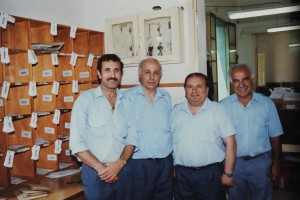 “Biex inlaħħqu mal-kwantità tal-posta, fi żmien il-Milied konna noħorġu nqassmu mat-8.00am. Konna nippakkjaw il-barżakki tagħna sa ruħ ommhom u nerħulha nduru mat-triqat dar dar. Minbarra l-ittri konna nqassmu anki xi pakketti iżda f’każ li l-pakketti jkunu kbar wisq, konna nħallu avviż ħalli dak li jkun imur jiġborhom mill-uffiċċju tal-Posta.”
“Biex inlaħħqu mal-kwantità tal-posta, fi żmien il-Milied konna noħorġu nqassmu mat-8.00am. Konna nippakkjaw il-barżakki tagħna sa ruħ ommhom u nerħulha nduru mat-triqat dar dar. Minbarra l-ittri konna nqassmu anki xi pakketti iżda f’każ li l-pakketti jkunu kbar wisq, konna nħallu avviż ħalli dak li jkun imur jiġborhom mill-uffiċċju tal-Posta.”“Matul il-bqija tas-sena, is-servizz tal-Posta kien jagħti garanzija li ittra li tintbagħat qabel is-7.00am kienet tasal għand ir-riċevitur dakinhar stess. Dan kien impossibbli li tiggarantih fi żmien il-Milied għalkemm konna nagħmlu ħilitna kollha biex il-posta tasal malajr kemm jista’ jkun. Konna nkunu konxji li ħafna kienu jkunu qed jistennewna bil-ħerqa. Sa 40 sena ilu, mhux kulħadd kellu telefon id-dar u l-posta kienet l-uniku mezz ta’ komunikazzjoni. Ngħidu aħna fost l-ittri ġieli kien ikun hemm noti tan-namrati li kienu jiktbu lil xulxin biex jifthemu fejn u fi x’ħin se jiltaqgħu. Mur fehmielhom din liż-żgħażagħ illum!”
“Meta l-internet kien għadu ineżistenti, kollox bil-posta kien jasal u għalhekk in-nies kellhom ċerta relazzjoni ta’ ħbiberija mal-pustier. Hekk kif induru l-kantuniera konna ndoqqu l-qanpiena tar-rota ħalli n-nies jindunaw li wasalna. Imma kien ikun hemm ukoll min ikun qed jistenniena fil-bieb tad-dar tiegħu. Fil-Milied in-nies kienu jilqgħuna b’mod speċjali u jpattulna tas-servizz li konna nagħtuhom matul is-sena kollha. Ħafna kienu jippreparawlna xi grokk u jekk ma noqogħdux attenti, nispiċċaw immorru kuljum fis-sakra d-dar! Kien hemm min jagħtina wkoll xi ħaġa tal-flus u konna ndabbruha tajjeb f’dawk il-ġranet. Kont tħossok apprezzat u allura x-xogħol kien jagħtik aktar sodisfazzjon.”
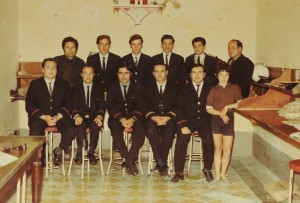 “Illum ċerti affarijiet inbidlu qatiegħ. Il-mezzi ta’ komunikazzjoni żdiedu u allura l-funzjoni tal-Posta ma baqgħetx daqshekk assoluta. Ħafna nies illum jaħdmu, inkluż in-nisa, u allura ssib inqas nies fid-djar filgħodu. Hemm ukoll il-fatt li llum meta jiżżewwġu ‘l ulied mhux neċessarjament qed jibqgħu joqogħdu fl-istess raħal jew belt fejn twieldu. Dan qed ninnutah fiż-Żejtun hekk kif m’għadux jikber bl-istess rata ta’ qabel. Inbidel ukoll it-tip ta’ bini u allura fejn dari il-pustier kien iħabbat bieb, bieb, dar, dar, illum jidħol ġol-entrata ta’ blokk ta’ appartamenti u jħalli l-ittri ġol-kaxxi mingħajr forsi qatt ma jara lir-riċevituri. B’hekk jista’ jkun li r-relazzjoni tan-nies mal-pustier ma baqgħetx li kienet. Madanakollu, jien li niftakar żminijiet oħra, għadni nilqa’ l-pustiera d-dar u ġieli noqgħod nitħaddet magħhom. Fi żmien il-Milied, kif ħaddieħor kien jagħmel miegħi, nagħtihom dik ix-xi ħaġa żgħira wkoll.”
“Illum ċerti affarijiet inbidlu qatiegħ. Il-mezzi ta’ komunikazzjoni żdiedu u allura l-funzjoni tal-Posta ma baqgħetx daqshekk assoluta. Ħafna nies illum jaħdmu, inkluż in-nisa, u allura ssib inqas nies fid-djar filgħodu. Hemm ukoll il-fatt li llum meta jiżżewwġu ‘l ulied mhux neċessarjament qed jibqgħu joqogħdu fl-istess raħal jew belt fejn twieldu. Dan qed ninnutah fiż-Żejtun hekk kif m’għadux jikber bl-istess rata ta’ qabel. Inbidel ukoll it-tip ta’ bini u allura fejn dari il-pustier kien iħabbat bieb, bieb, dar, dar, illum jidħol ġol-entrata ta’ blokk ta’ appartamenti u jħalli l-ittri ġol-kaxxi mingħajr forsi qatt ma jara lir-riċevituri. B’hekk jista’ jkun li r-relazzjoni tan-nies mal-pustier ma baqgħetx li kienet. Madanakollu, jien li niftakar żminijiet oħra, għadni nilqa’ l-pustiera d-dar u ġieli noqgħod nitħaddet magħhom. Fi żmien il-Milied, kif ħaddieħor kien jagħmel miegħi, nagħtihom dik ix-xi ħaġa żgħira wkoll.”Missieri daħal jaħdem bħala pustier meta kellu 18 il-sena.
“Iz-ziju Ċikku kien jaqra l-gazzetti kuljum u kien hu li qalli li kienu fetħu l-applikazzjonijiet għall-pustiera ġodda. Ta’ 16 il-sena temmejt l-edukazzjoni tiegħi u bħal għadd ta’ nies oħra spiċċajt nirreġistra. Kien ikun hemm ringieli sħaħ ta’ mijiet ta’ nies jirreġistraw għax ma tantx kien hemm xogħol. Biex tilħaq pustier kien ikollok toqgħod għall-eżamijiet bil-miktub fil-Matematika, l-Ingliż u l-Ġografija u ridt tiġi minn ta’ quddiem. Meta dħalt jien kienu applikaw madwar 170 u għażlu 50.”
 “Dħalt naħdem fl-uffiċċju tal-Posta taż-Żejtun li dak iż-żmien kien ikopri wkoll lil Ħal-Għaxaq, il-Gudja, Marsaxlokk u Birżebbuġa. L-ewwel ħmistax kont tqattagħhom titgħallem ir-rotta li tkun ġiet assenjata lilek. Kont tmur issegwi pustier ieħor ħalli tara kif jaħdem. F’dawk il-ġranet kont mistenni titgħallem l-ismijiet tat-toroq u tkun taf fejn huma d-djar. Jien ma kelli l-ebda problema f’dan il-qasam peress li minn tfuliti kont nixtieq insir pustier. Kont affaxxinat bit-toroq u bl-ismijiet tagħhom u għalhekk kont diġà qbadt nitgħallimhom bl-amment. Imma xorta waħda kien hemm triqat jew sqaqien fiż-Żejtun li ssorprendewni għax qatt ma kont dħalt fihom qabel. Aktar il-quddiem imbagħad kelli l-opportunità li nsir naf it-triqat ta’ partijiet ta’ Ħal-Għaxaq u tal-Gudja peress li kont inqassam hemm ukoll.”
“Dħalt naħdem fl-uffiċċju tal-Posta taż-Żejtun li dak iż-żmien kien ikopri wkoll lil Ħal-Għaxaq, il-Gudja, Marsaxlokk u Birżebbuġa. L-ewwel ħmistax kont tqattagħhom titgħallem ir-rotta li tkun ġiet assenjata lilek. Kont tmur issegwi pustier ieħor ħalli tara kif jaħdem. F’dawk il-ġranet kont mistenni titgħallem l-ismijiet tat-toroq u tkun taf fejn huma d-djar. Jien ma kelli l-ebda problema f’dan il-qasam peress li minn tfuliti kont nixtieq insir pustier. Kont affaxxinat bit-toroq u bl-ismijiet tagħhom u għalhekk kont diġà qbadt nitgħallimhom bl-amment. Imma xorta waħda kien hemm triqat jew sqaqien fiż-Żejtun li ssorprendewni għax qatt ma kont dħalt fihom qabel. Aktar il-quddiem imbagħad kelli l-opportunità li nsir naf it-triqat ta’ partijiet ta’ Ħal-Għaxaq u tal-Gudja peress li kont inqassam hemm ukoll.”“Ix-xogħol mill-ewwel għoġobni. Toqgħod iddur fit-toroq u l-isqaqien u tgħid ara das-sqaq qatt ma rajtu qabel! U n-nies kienu dħulin. Kienu jħobbuna ħafna u jafdaw ħafna fina. Uħud meta jirċievu xi ittra kienu jistaqsuni ‘Ta’ x’hiex inhi?’ U ngħidilhom tal-income tax jew tal-Awstralja per eżempju. Kif ngħidilhom tal-Awstralja kien ikun hemm min jistaqsini mingħand min għax kien ikollhom ħafna tfal hemm. U ġieli kien hemm min kien idaħħalni d-dar, jagħmilli belgħa tè, jpoġġi miegħi mal-mejda u joqgħod jismagħni naqralu l-ittra.”
“Fil-bidu pustier ġdid ma kienx ikollu r-rotta tiegħu imma kien iservi bħala sostitut sabiex jagħmel tajjeb għal meta pustiera oħra jkollhom bżonn jieħdu l-leave jew ikunu ma jifilħux. Iż-Żejtun kien maqsum f’erbgħa sezzjonijiet u ftit ftit kont tasal sakemm titgħallem ir-rotot kollha. Wara 5 snin kont tieqaf tissostitwixxi u jkollok ir-rotta tiegħek.”
 “Ix-xogħol ta’ pustier kien jinkludi li jinġabru l-ittri mill-kaxxi tal-ittri pubbliċi kollha taż-Żejtun, il-Gudja, Marsaxlokk u Birżebbuġa fis-7.00am u jittieħdu l-uffiċċju. Imbagħad l-ittri kollha kienu jitqassmu skont id-distrett tagħhom. Dawk l-ittri li kienu se jitqassmu mill-Posta taż-Żejtun kienu jinżammu filwaqt li l-oħrajn kienu jintbagħtu ma’ vann li jiġi jiġborhom biex jeħodhom fl-uffiċċju prinċipali tal-Belt. L-ittri li jinżammu kienu jiġu rranġati skont ir-rotot u kif inlestu noħorġu nqassmuhom fid-djar. Kollox kellu jitqassam dakinhar stess u kif tlesti stajt tmur lejn id-dar. Min kien imur idur bil-mixi u min bir-rota u għal dawk ir-residenti li kienu joqogħdu fl-imbiegħed, bħall-inħawi tal-bajja ta’ San Tumas u Ħal-Far, il-pustier kien imur bil-mutur. Għal xi l-10.00am kien jasal vann ieħor mill-Belt li kien iġib il-posta li jkunu rċevew l-uffiċċji tal-posta l-oħra.”
“Ix-xogħol ta’ pustier kien jinkludi li jinġabru l-ittri mill-kaxxi tal-ittri pubbliċi kollha taż-Żejtun, il-Gudja, Marsaxlokk u Birżebbuġa fis-7.00am u jittieħdu l-uffiċċju. Imbagħad l-ittri kollha kienu jitqassmu skont id-distrett tagħhom. Dawk l-ittri li kienu se jitqassmu mill-Posta taż-Żejtun kienu jinżammu filwaqt li l-oħrajn kienu jintbagħtu ma’ vann li jiġi jiġborhom biex jeħodhom fl-uffiċċju prinċipali tal-Belt. L-ittri li jinżammu kienu jiġu rranġati skont ir-rotot u kif inlestu noħorġu nqassmuhom fid-djar. Kollox kellu jitqassam dakinhar stess u kif tlesti stajt tmur lejn id-dar. Min kien imur idur bil-mixi u min bir-rota u għal dawk ir-residenti li kienu joqogħdu fl-imbiegħed, bħall-inħawi tal-bajja ta’ San Tumas u Ħal-Far, il-pustier kien imur bil-mutur. Għal xi l-10.00am kien jasal vann ieħor mill-Belt li kien iġib il-posta li jkunu rċevew l-uffiċċji tal-posta l-oħra.”“Qattgħajt 22 sena niġri bir-rota u nqassam l-ittri. Bħal kull xogħol hemm is-sabiħ u l-ikraħ tiegħu. Fis-sajf kont tbati mis-sħana u mill-qilla tax-xemx imma fix-xitwa kien wisq agħar għax kont tixxarrab jekk ikun il-maltemp u tirriskja li tlaqqgħat xi riħ. Kien hemm ukoll problema bil-klieb tan-nies li ġieli kienu jħebbu għalik kif jarawk riesaq. Darba minnhom gidimni kelb u ċarratli l-qalziet tal-uniformi.”
“Wara 22 sena ngħatajt promozzjoni u lħaqt Mail Officer u xogħoli kien fuq ġewwa biss. Meta għaddew 10 snin oħra lħaqt Mail Inspector u hemm ġejt responsabbli mill-uffiċċju tal-Posta taż-Żejtun. Matul is-snin rajt diversi żviluppi jseħħu fosthom l-introduzzjoni ta’ pustiera nisa li qabel kienu jiġu evitati biex ma jkunx hemm taħlit bejn nisa u rġiel. Finalment ta’ 55 sena ħriġt bil-pensjoni.”
 Illum missieri jgħodd is-70 sena iżda għalkemm għaddew 15 il-sena minn mindu waqaf mix-xogħol, għadu jiftakar ċar l-ismijiet kollha tat-triqat tal-inħawi li ħadem fihom, in-numri tad-djar u saħansitra l-kunjomijiet tas-sidien tagħhom ukoll.
Illum missieri jgħodd is-70 sena iżda għalkemm għaddew 15 il-sena minn mindu waqaf mix-xogħol, għadu jiftakar ċar l-ismijiet kollha tat-triqat tal-inħawi li ħadem fihom, in-numri tad-djar u saħansitra l-kunjomijiet tas-sidien tagħhom ukoll.“Sal-bieraħ iltqajt ma’ waħda ġo ħanut li kellha madwar 40 sena. X’ħin ratni qaltli ‘Tiftakar kemm kont tagħtina posta?’ Għall-ewwel m’għarafthiex imma meta semmietli t-triq fejn kienet toqgħod, stajt ngħidilha n-numru tal-bieb tagħhom u l-kunjom tal-familja. Stagħġbet li kont għadni niftakar wara tant snin!”
Meta tkun qattgħajt daqstant żmien taħdem bħala pustier diffiċli tinsa l-informazzjoni kollha li tkun immemorizzajt. Missieri jistqarr li kultant għadu joħlom li qiegħed idur bir-rota madwar it-toroq iqassam l-ittri lin-nies.
(Dan l-artiklu ġie ppubblikat fis-suppliment Senior Times li ħareġ mal-ġurnal The Times of Malta tal-15 ta’ Diċembru 2017)
-
MAN ON A MISSION
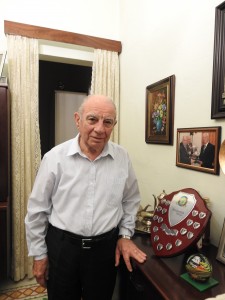 “Ageing should not be a barrier in life but a further opportunity to excel,” insists 80-year-old Angelo Zahra who has recently been selected to receive the main prize in the award ‘Premju Anzjanità Attiva’ (Award for the Active Ageing) for his voluntary management of three homes for the disabled.
“Ageing should not be a barrier in life but a further opportunity to excel,” insists 80-year-old Angelo Zahra who has recently been selected to receive the main prize in the award ‘Premju Anzjanità Attiva’ (Award for the Active Ageing) for his voluntary management of three homes for the disabled.Zahra studied mechanical engineering at the Dockyard Technical College and for several years, he served in managerial roles. Before his retirement, at age 63, he was the Director of the Manufacturing and Services Department with the Government of Malta.
“I have known Fr Angelo Seychell since his priesthood and I have always admired his work. When he founded the Nazareth Foundation in 1995 and opened his house to provide a home for people with special needs, I supported his venture by collecting donations from my colleagues twice a year. However, I was not directly involved with Dar Nazareth.”
 Yet Fr Seychell had for long earmarked Zahra to help him develop his mission to create a warm family environment in which people with disabilities could lead a good and respectful life which gave them the possibility to be happy and to achieve their full potential.
Yet Fr Seychell had for long earmarked Zahra to help him develop his mission to create a warm family environment in which people with disabilities could lead a good and respectful life which gave them the possibility to be happy and to achieve their full potential.“As soon as I retired, Fr Seychell approached me and asked me to consider serving as the administrator of Dar Nazareth. I accepted on condition to start three months later since I had promised my wife that I would finally take a much-awaited break from work. In the meantime, my wife and I booked a tour to Lourdes and to our great surprise we found out that the group which we were going to travel with were none other than Fr Seychell, his volunteers and the residents at Dar Nazareth. This was a golden opportunity to get to know everyone better and soon, I was deeply involved with the Nazareth Foundation.”
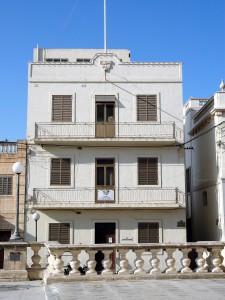 “In September 2000, when I joined in, there were only five residents at Dar Nazareth. However, in a short time, the house was elaborated to receive a further five residents where it reached its full capacity. A year later, the Foundation rented a workshop wherein our residents could attend daily to entertain themselves and to make crafts which could be sold to the public.”
“In September 2000, when I joined in, there were only five residents at Dar Nazareth. However, in a short time, the house was elaborated to receive a further five residents where it reached its full capacity. A year later, the Foundation rented a workshop wherein our residents could attend daily to entertain themselves and to make crafts which could be sold to the public.”Dar Nazareth addressed a demand which had been stalled for several years. Soon, its success lead to the establishment of two other houses.
“In 2004, the Foundation opened the second house, Dar l-Arċipriet Degabriele, which welcomed a further nine residents. Five years later, the third house, Dar Jean Vanier, opened its doors to another nine residents.”
While in the beginning Dar Nazareth was operated by volunteers, the increase in residents and houses required the engagement of full-time workers.
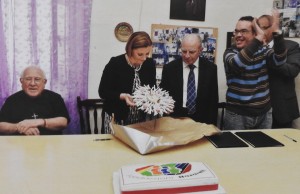 “The funding of such projects is always one of the major stumbling blocks. The Foundation had succeeded to purchase two properties and develop them into residential homes. It also managed to acquire enough money to fund the salary of 30 full-time workers. Nevertheless, the sourcing of further income to sustain all the expenses required to keep these three homes functioning are a constant responsibility. Thankfully, in 2016, the Government signed an agreement with Nazareth Foundation through which it was given 1.4 million euro over a period of three years. This serves as a safety net for the Foundation’s administration to provide the best service possible to its residents.”
“The funding of such projects is always one of the major stumbling blocks. The Foundation had succeeded to purchase two properties and develop them into residential homes. It also managed to acquire enough money to fund the salary of 30 full-time workers. Nevertheless, the sourcing of further income to sustain all the expenses required to keep these three homes functioning are a constant responsibility. Thankfully, in 2016, the Government signed an agreement with Nazareth Foundation through which it was given 1.4 million euro over a period of three years. This serves as a safety net for the Foundation’s administration to provide the best service possible to its residents.”For the past 17 years, Zahra has voluntarily taken in hand the management of these three homes and presently he also acts as President of the Nazareth Foundation Board.
 “This work has become my mission to do something worthwhile with my available time. It gives me utter satisfaction to see our residents living in a friendly and family environment where they can feel safe, at ease, and loved. Their appreciation and happiness in return give me a sense of fulfilment and help me to feel much younger.”
“This work has become my mission to do something worthwhile with my available time. It gives me utter satisfaction to see our residents living in a friendly and family environment where they can feel safe, at ease, and loved. Their appreciation and happiness in return give me a sense of fulfilment and help me to feel much younger.”(This feature was published in the Senior Times supplement issued with The Times of Malta on 15 December 2017)
-
LIGHTS OUT FOR CHRISTMAS
Christmas time and the days preceding it are generally associated with colour, light, optimism and fun. Yet this was not the case in 1939 when the Christmas season became synonymous with gloom, darkness, uncertainty and fear.
On 18 September 1939, a table showing the duration of the ‘Official Night’ was published in Government Notice No. 459 in The Malta Government Gazette. This table included each day of each month and the beginning and end of what was to be considered as the official night hours. Such instructions formed part of the Malta Defence Regulations, 1939, which aimed to protect the Maltese Islands and its inhabitants as World War II ravaged in other countries.
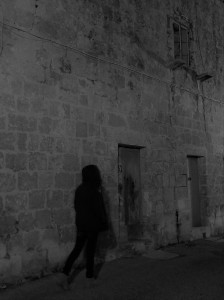 Two days later, on 20 September 1939, Government Notice No. 473 issued the Lights Restriction Order which was effective from that day. The directions of this Order had to be observed between midnight and 4:30am on every day of the week, and also between 10:00pm and midnight on Fridays. During these times, all lights in any building had to be masked to be invisible from the sea and from the air. No lights, other than lights authorised by the competent authority, were permitted in any open spaces whether private or public, in yards, roofs or open verandas. The use of illuminated lettering or signs in any shops were prohibited unless authorised by the Commissioner of Police or the competent authority. The traffic of motor vehicles during these hours was banned and any vehicles which did not comply with these provisions could be stopped and detained until 6:00am. Obviously, all fireworks were also prohibited.
Two days later, on 20 September 1939, Government Notice No. 473 issued the Lights Restriction Order which was effective from that day. The directions of this Order had to be observed between midnight and 4:30am on every day of the week, and also between 10:00pm and midnight on Fridays. During these times, all lights in any building had to be masked to be invisible from the sea and from the air. No lights, other than lights authorised by the competent authority, were permitted in any open spaces whether private or public, in yards, roofs or open verandas. The use of illuminated lettering or signs in any shops were prohibited unless authorised by the Commissioner of Police or the competent authority. The traffic of motor vehicles during these hours was banned and any vehicles which did not comply with these provisions could be stopped and detained until 6:00am. Obviously, all fireworks were also prohibited.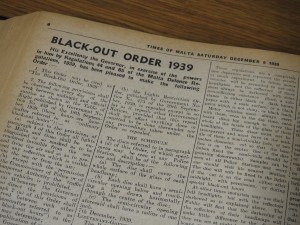 An Air-Raid Precautions Order was communicated in Government Notice No. 504 on 4 October 1939. Eventually on 9 December 1939, The Times of Malta published the provisions of The Black-Out Order, 1939, which had to be observed on every day of the week between midnight and the official sunrise. During these hours, all the lights on the Islands had to be extinguished or masked as to be rendered invisible from the sea and from the air. Special Black-Out hours could also be determined when necessary.
An Air-Raid Precautions Order was communicated in Government Notice No. 504 on 4 October 1939. Eventually on 9 December 1939, The Times of Malta published the provisions of The Black-Out Order, 1939, which had to be observed on every day of the week between midnight and the official sunrise. During these hours, all the lights on the Islands had to be extinguished or masked as to be rendered invisible from the sea and from the air. Special Black-Out hours could also be determined when necessary. As part of the Black-Out Order, from 14 December 1939, all motor vehicles which had to travel at night, other than those belonging to His Majesty’s service, had to have their bulbs removed from their lamps. Opaque cardboard discs were to be fixed to the lights of the vehicles and the reflectors’ surface had to be covered with a non-reflecting substance. A white disc had to be affixed at the back of all motor vehicles at a height of three feet from the ground to make them visible on the roads. Traffic of motor vehicles during the black-out was prohibited except for those who obtained permission from the Commissioner of Police or a competent authority.
Another notice which appeared on The Times of Malta of the 9 December 1939 urged the inhabitants to comply with these regulations for their own safety. People were recommended to stay at home and to avoid going out in the darkness. Those who needed to get out were advised to walk on the right-hand side of the road to face oncoming traffic and to carry with them a white object to make them more visible to drivers. Owners of goats were informed to keep their animals off the road at night. On the other hand, drivers were cautioned to drive very slowly and with great care.
Measures were being taken to prepare the people how to take the necessary precautions in preparation of an expected war. Black-outs intended to prevent crews of enemy aircraft from being able to identify their targets by sight. Nonetheless, these precautionary provisions proved to be one of the more unpleasant aspects of war, disrupting many civilian activities and causing widespread grumbling and lower morale.
The Times of Malta of 13 December 1939 reports that some misapprehension had arisen among that section of the public who had to rise early for work and travel by early buses, since it was not clear at what time the bus service started. Indeed, all buses were to continue their usual service provided that they adhered to the regulations regarding headlights and lights, including the inside of the vehicles which had to remain in darkness.
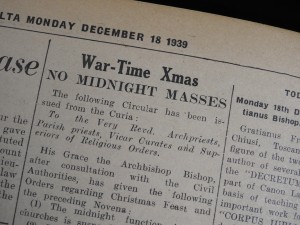 Even though the Maltese Islands were not yet directly involved in war, a foreboding atmosphere crept its way into the lives of people. As if matters were not yet miserable enough, a Bishop’s Circular which was published on The Times of Malta of 17 December 1939 declared that the Christmas midnight function in the churches was to be suspended. The Novena and feast functions could be celebrated from 4:00am onwards provided that no lights were visible from the outside. Those churches which required singers and musicians from far places for the early Christmas function had to apply to the Commissioner of Police for the necessary permits to travel. While it was permissible to give a small sign to the faithful by the ringing of bells for the function of the Novena and Christmas Eve, this had to be done according to predetermined rules.
Even though the Maltese Islands were not yet directly involved in war, a foreboding atmosphere crept its way into the lives of people. As if matters were not yet miserable enough, a Bishop’s Circular which was published on The Times of Malta of 17 December 1939 declared that the Christmas midnight function in the churches was to be suspended. The Novena and feast functions could be celebrated from 4:00am onwards provided that no lights were visible from the outside. Those churches which required singers and musicians from far places for the early Christmas function had to apply to the Commissioner of Police for the necessary permits to travel. While it was permissible to give a small sign to the faithful by the ringing of bells for the function of the Novena and Christmas Eve, this had to be done according to predetermined rules.Albeit the continuous warnings and pleas to adhere strictly to the black-out orders, it seemed that not everyone was following the rules. An announcement on The Times of Malta of the 20 December 1939 issued by the Lieutenant’s Government Office advised the public that the black-out on the night of December 15-16 was not entirely satisfactory, and that there were several lights showing in the Valletta, Sliema, Hamrun, Cospicua and Naxxar districts. Several lights were only put out as aircraft passed overhead. This notice pointed out also that a section of the public could still have been unaware of the black-out rules since they seemed to have been published only on The Times of Malta and Il-Berqa newspapers. Illiterate persons would therefore have had no way of being forewarned except by hearsay. Therefore, a siren warning which was different from the Air-Raid alarm signal, was recommended to be given throughout the islands at sunset.
Letters by readers in the Correspondence section of The Times of Malta of the 20 and 21 December 1939 vent their frustration and contempt at those who were not taking these black-out precautions seriously:
“Many people rather irresponsibly remark that they do not quite see the use of strict black-outs when Germany is at such a distance away. The reply is that precaution is better than cure. I am sure that these people will think very different if they find one day a German bomb dropping at their door-step or in their backyard, just because some stray lights guided an enemy to an objective.” Signed ‘Common-Sense’.
“I am sure that a number of law-abiding citizens in these islands feel that the time has come for coercion to replace coaxing. Those people who scorn to comply with reasonable regulations are either knaves or fools and most dangerous to the community in war time; they should be under lock and key for the duration of the war: either in jail or in a lunatic asylum. The pathetic appeals made by the authorities are becoming nauseating.” Signed Lieutenant Colonel (retired) H. M Marshall.
 Special Black-Out arrangements for Christmas and New Year, published on The Times of Malta of the 23 and 30 December 1939, informed the public that the black-out of buildings on the nights of 24 – 27 December and 30 December – 1 January were to be postponed for one and a half hours from midnight. On these nights, motor vehicles were allowed on the road without requiring special permission until 1:30am, and shops and places of entertainment could remain open until 1:00am.
Special Black-Out arrangements for Christmas and New Year, published on The Times of Malta of the 23 and 30 December 1939, informed the public that the black-out of buildings on the nights of 24 – 27 December and 30 December – 1 January were to be postponed for one and a half hours from midnight. On these nights, motor vehicles were allowed on the road without requiring special permission until 1:30am, and shops and places of entertainment could remain open until 1:00am.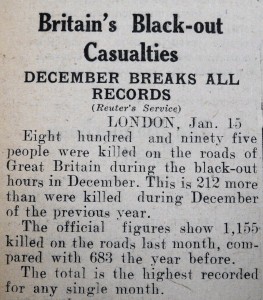 Possibly few had considered that light could be their enemy until it became essential to extinguish it. There was no mention of accidents or fatalities due to the black-out on the Islands in the December’s Times of Malta newspapers. However, reports from Great Britain relating to the high increase in road fatalities during the night were quite shocking. On 13 December 1939, the British Official Press stated that road fatalities had increased considerably from September to November. Yet the worst scenario took place in December, as reported by the Reuter’s Service on 16 January 1940, when 895 people were killed on the roads of Great Britain during the black-out hours. This was 212 more than those who were killed during December of the previous year.
Possibly few had considered that light could be their enemy until it became essential to extinguish it. There was no mention of accidents or fatalities due to the black-out on the Islands in the December’s Times of Malta newspapers. However, reports from Great Britain relating to the high increase in road fatalities during the night were quite shocking. On 13 December 1939, the British Official Press stated that road fatalities had increased considerably from September to November. Yet the worst scenario took place in December, as reported by the Reuter’s Service on 16 January 1940, when 895 people were killed on the roads of Great Britain during the black-out hours. This was 212 more than those who were killed during December of the previous year.This was surely a strange Christmas to the Maltese people who are accustomed to celebrate these days in a profuse way. Although through no fault of their own, they were involved in war and they had to adapt to war conditions. Alas, much worse was yet to come.
(This article was published in the Christmas Times magazine issued with The Times of Malta dated 13 December 2017)
-
Long shell life
 Although during the Christmas season, it is customary to see statues of baby Jesus in a manger or in a crib, in Candice Fava’s shop New EGGsperience, the holy child would be seen resting in a decorated eggshell.
Although during the Christmas season, it is customary to see statues of baby Jesus in a manger or in a crib, in Candice Fava’s shop New EGGsperience, the holy child would be seen resting in a decorated eggshell.“I love to create unique hand-made objects and this craft of eggshell decoration has provided me with the opportunity to have my own niche market,” Fava explains.
Fava was raised on a farm in Australia, where her family sold eggs. They had several clients but one particular client intrigued Fava since she regularly purchased a substantial quantity of eggs.
“One day I decided to ask her why she always needed so many eggs and she promised that the next time she called at our farm, she would bring me a gift to show me. I felt deeply curious and I awaited her next visit with much anticipation. Eventually, she brought me a little jewel box adorned with lovely fabrics and accessories. I could not believe that she had actually made it with one of the eggs from our farm!”
 Fava was so fascinated with this idea that she decided to learn this craft. At the farm, she had all the eggs that she required and in time she learnt how to clean them without breaking them. Soon, she was producing her own eggshell decorations.
Fava was so fascinated with this idea that she decided to learn this craft. At the farm, she had all the eggs that she required and in time she learnt how to clean them without breaking them. Soon, she was producing her own eggshell decorations.“The first item I made was a jewel box which I painted with bright nail polish. I was so delighted when I saw it ready! Today I realize that it wasn’t much but it is still very dear to me as it reminds me from where it all started.”
Along the years, eggshell decoration became an integral part of Fava’s life. Which explains why she was surprised when she came over to Malta and realized that this craft was totally unknown on the island.
“It was hard at first to find the necessary materials to work with. However, my husband Ivan helped me to locate some local farms which could provide me with eggs. He also assisted me in the cleaning and sterilization of the eggshells.”
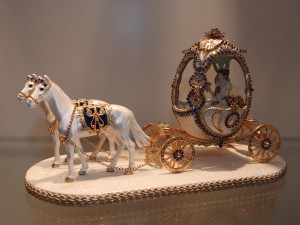 Initially she decorated eggshells for her personal enjoyment. Then she began to give them out as gifts to her friends.
Initially she decorated eggshells for her personal enjoyment. Then she began to give them out as gifts to her friends.“My friends were delighted with these eggshell decorations since they had never seen anything like them before. Soon they were asking me to make some more creations for them so that they could give them as presents to others. It was only a matter of time until I confirmed that there was a demand for such products.”
Ultimately, people’s positive reactions to her craft led her to open her own shop in Zabbar.
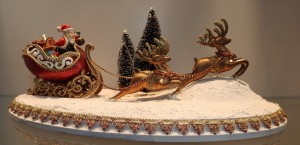 “By then, I had produced so many various eggshell decorations that I had no difficulty to fill the shop with my creations. Each time that new clients come in, it is charming to see their incredulity that so many exquisite things can be made from common fragile eggshells.”
“By then, I had produced so many various eggshell decorations that I had no difficulty to fill the shop with my creations. Each time that new clients come in, it is charming to see their incredulity that so many exquisite things can be made from common fragile eggshells.”Nowadays, the Favas have located foreign suppliers who are able to furnish them with quantities of ready-made cleaned and sterilized eggshells. Moreover, they have also managed to establish contacts with suppliers of other materials with which the eggshells are decorated.
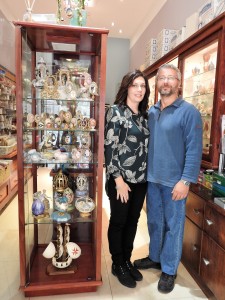 “My husband supports me a lot and helps me to come out with new ideas. Along the years, he too became enthusiastic about this work and now he is able to make his own creations.”
“My husband supports me a lot and helps me to come out with new ideas. Along the years, he too became enthusiastic about this work and now he is able to make his own creations.”A wide range of differently decorated eggshells which are ideal as gifts for various occasions are displayed at their shop. However, a few of them are not for sale.
“When we join forces, we create the best decorations,” the two agree. “The collaboration of ideas lead to exclusive objects which become difficult to part from. Some of them, such as the lamp shade, the handbag set and the sea vessel, are cherished objects and we have won prestigious awards for them at local national craft competitions. Such works provide us also with the opportunity to combine different materials and crafts like woodwork and eggshell decoration. Our imagination has no limit, however we are restrained with the eggshells’ curvatures, although we take that as part of the challenge.”
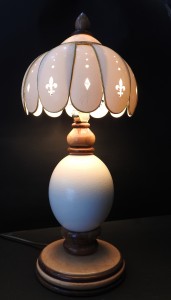 Even though all of the creations may serve as decorations, some of them also have their own practical use, acting as exotic containers, wearable accessories or light fittings.
Even though all of the creations may serve as decorations, some of them also have their own practical use, acting as exotic containers, wearable accessories or light fittings.“Besides selling our creations from my shop, I also participate in several fairs and exhibitions and therefore more people are getting to know about this craft. Presently I am also taking part in the program Niskata which airs on TVM. Yet there is still much more to do to create more awareness.”
“It is great to see how far a simple hobby can take you. Little by little, all my family has become involved in this craft. In fact, my daughter is already coming up with her own designs and creations and my little son is showing interest too.”
In these last years, Fava has also dedicated herself to teach this craft to all those who are interested, both children and adults. She has also furnished her shop with all the necessary materials including eggshells of various sizes, cut eggshells, acrylic paints, stands, bases and a multitude of other items.
As Christmas time approaches, the two explore the possibility of new designs and ideas in order to come out with original creations which relate to this theme.
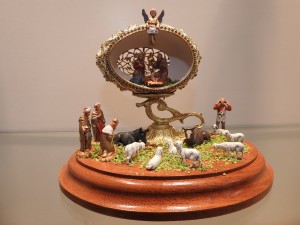 “We are always dreaming of what we are going to do next. We work with all sorts of eggshells, starting with the smallest ones of love-birds and parrots, and moving on to larger ones such as those of pigeons, quails, ducks, geese, emu, rhea and ostrich. The geese’s eggs are the most practical because of their size and shape. Other eggs are relished for their natural particular characteristics such as the blackish colour of the rhea eggs and the large shape and pearly shade of the ostrich eggs.”
“We are always dreaming of what we are going to do next. We work with all sorts of eggshells, starting with the smallest ones of love-birds and parrots, and moving on to larger ones such as those of pigeons, quails, ducks, geese, emu, rhea and ostrich. The geese’s eggs are the most practical because of their size and shape. Other eggs are relished for their natural particular characteristics such as the blackish colour of the rhea eggs and the large shape and pearly shade of the ostrich eggs.”“Christmas brings a lot of joy and memories. This festive season opens up a whole new world to create related items with baby Jesus statues, cribs, angels, Father Christmas, reindeers, sparkles and a whole range of bright colours. We love to reflect the warm meaning of Christmas in our works.”
Travelogue
Archives
Recent Posts
- A MATTER OF FATE
- MALTA’S PREHISTORIC TREASURES
- THE MAGIC IS IN THE DETAIL
- THE SELLING GAME
- NEVER FORGOTTEN
- Ġrajjiet mhux mitmuma – 35 sena mit-Traġedja tal-Patrol Boat C23
- AN UNEXPECTED VISIT
- THE SISTERS OF THE CRIB
Comments
- Pauline Harkins on Novella – Li kieku stajt!
- admin on IL-KARNIVAL TRAĠIKU TAL-1823
- Albert on IL-KARNIVAL TRAĠIKU TAL-1823
- Martin Ratcliffe on Love in the time of war
- admin on 24 SENA ILU: IT-TRAĠEDJA TAL-PATROL BOAT C23